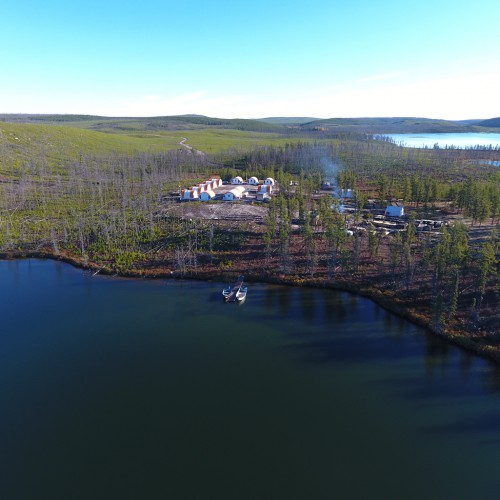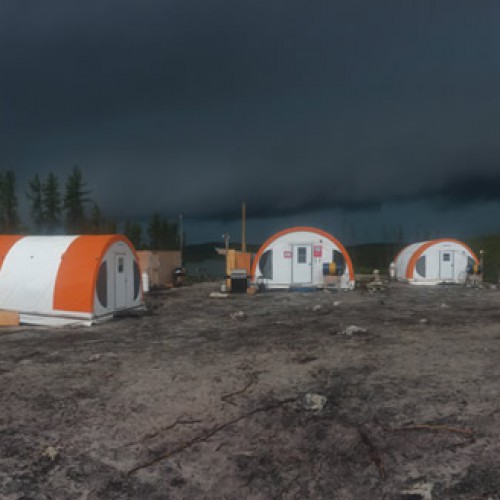Christie Lake
Christie Lake
The Christie Lake Project is host to the Paul Bay, Ken Pen, Ōrora, and Sakura Uranium Deposits. The Company holds a 65.55% direct interest in The Project in a joint venture with JCU (Canada) Exploration Ltd. (“JCU”), and a further 17.23% indirectly through its 50% ownership of JCU. The Paul Bay and Ken Deposits were originally discovered by PNC Exploration (Canada) Co. Ltd. (“PNC”), in 1989 and 1993 respectively. The Project was dormant from 1997 though to 2016 when it was optioned from JCU by UEX Corp. (“UEX”). UEX went on to discover the Ōrora Zone in 2017. The Sakura Zone was discovered in the summer of 2022, following shortly after the acquisition of UEX by UEC. The ultimate size of the Paul Bay, Ken Pen, Ōrora and Sakura Deposits has not been fully defined and they remain open at depth and along strike.
- Total Inferred Resource estimate for the three deposits is 20.35 M lb. U3O8 at an average grade of 1.57%.
- Resources attributable to UEC from Christie Lake are 16.84 M lb. U3O8
The Christie Lake project is 9 km northeast of the McArthur River Uranium Mine, one of the world’s largest uranium producers. The Project straddles the Eastern Athabasca High Grade Uranium Corridor and is the uranium land package that is not controlled by Cameco and Orano between the two Cameco-operated world class uranium operations at McArthur River and Cigar Lake.
UEC’s current focus is to test targets along the Yalowega Trend, a 4.2 km corridor with anomalous uranium and indicative hydrothermal alteration that hosts the three known high-grade uranium deposits, Paul Bay, Ken Pen, and Ōrora as well as the recently discovered Sakura Zone. Several high-priority targets that include follow-up of historic mineralized holes have yet to be tested along the Yalowega Trend. These targets have great potential to yield additional uranium discoveries.
The Christie Lake Project was owned and operated by PNC from 1985 to 2000 and the project was actively explored by PNC from 1985 to 1997. In November of 2000, JCU acquired 100% ownership of the project, but active exploration did not resume until January of 2016, when JCU entered into an option agreement with UEX. In August of 2021, UEX and Denison each acquired 50% interest in JCU. Subsequently, in August of 2022, UEC acquired UEX. In total, 96,160 m of drilling in 200 drill holes have been completed on the Project between 1988 and 2021.
The Christie Lake project area is in Athabasca Basin where Athabasca Group sandstone sits on older folded and faulted metamorphosed basement. The Athabasca Group sandstone is covered by 30 to 90 m of glacial boulders, sand, and gravel forming extensive drumlins and esker features.
The northeast trending P2 Fault structure, that is host to all the uranium at the nearby McArthur River mine, the world’s largest high-grade uranium mine, extends onto the Christie Lake property. This structure continues to the northeast onto Christie Lake where it is referred to as the Yalowega Trend.
Along the Yalowega Trend, the unconformity between the sandstone and basement rocks is approximately 420 m below surface. The uranium mineralization is associated with the primary structural zone that is a left-lateral strike slip fault associated with zones of graphite within the basement metasedimentary rocks.
The Yalowega Trend hosts three known unconformity-related uranium deposits; Ken Pen, and Ōrora. Paul Bay and Ken Pen were discovered by the previous operator in 1989 and 1993 respectively. Ōrora was discovered by UEX in 2017. The Sakura Zone was discovered by UEC in the summer 2022 following shortly after the acquisition of UEX.
The Paul Bay Zone is a basement-hosted uranium deposit occurring wholly within faulted basement rocks. The mineralized zone is 80 m wide and occurs as shoots plunging up to 200 m down-dip into the basement. The Yalowega Trend Fault at the unconformity up-plunge from the Paul Bay Deposit has yet to be tested and represents a great exploration target for a future drill program.
The Ōrora and Ken Pen Zones are unconformity uranium deposits which occur within faulted rocks straddling the unconformity. These zones extend lengthwise up to 160 m along the trend with shoots of mineralization and alteration that extend into the. The Ken Pen Deposit extends up to 80 m into the basement, however the full extent of these zones into the basement has not been tested.
Several conductive packages trend northeast through the central and southern portion of the Christie Lake property and have never been examined and tested with drilling. This presents a future exploration target beyond the P2 fault the trends onto the property from McArthur River.
Canada Careers
| Position | Location | Description |
|---|---|---|
| District Geologist Posting Saskatchewan | Saskatchewan | |
| Junior Geologist Posting Saskatchewan | Saskatchewan |
To apply for any of the above positions, send your resume and qualifications to: [email protected].










